Last updated: November 29, 2024
January 1st is called New Year's Day (Taishogatsu), while January 15th is called Koshogatsu. This is due to the fact that the 15th day of the full moon was thought to be a break, but due to the influence of calendaring from China, the 1st day gradually came to be celebrated as New Year's Day, and the traditional 15th day was called Small New Year. Now it looks like this. Various events were held during the New Year, one of which was the Sei no Kami event.
The Sei-no-kami event is an event that is held nationwide, and involves gathering New Year's pine decorations and Shimekazari in one place and burning them. It has different names in different places, such as Dondoyaki, Sagicho, Saitoyaki, and Saitobarai. In this event, there is a belief that fire is considered sacred, and people hold up a written kajime to the fire, saying that exposing one's body to a burning fire will make one's body strong, and that eating dumplings roasted over a burning fire will prevent illness. It is said that if you soar high, your handwriting will improve.
In eastern Japan, it is often associated with the belief in Dosojin. Dosojin is a god that prevents the invasion of evil spirits, and is also enshrined at village boundaries and crossroads, so he has the character of protecting people's journeys.
In Inagi City, the Sai no Kami ceremonies have been held since ancient times in each hamlet or religious group in each region. In the 1940s, some areas stopped holding them or they faded away, but they were revived in the 1960s and 1970s and have continued to this day. Since their revival, the implementing organization, content, schedule, and scale have often changed. So let's try to restore the Sai no Kami ceremonies from long ago.
Building a hut for the god of death
From around the time of Nanakusa, elementary and junior high school students took the lead in procuring materials such as bamboo, wood, and straw for building huts (note: also called yagura). They go from house to house collecting New Year's decorations. Around the 11th, a hut is built for the shrine god. The frame of the hut is made of bamboo or wood in a conical shape, and is surrounded by straw and decorations. When the hut is completed, the Dourokujin stone is enshrined inside.
After the hut is completed
For several days after the hut is completed and before it is burnt down, the children sleep inside the hut and protect it. This is because young people from other regions come and set the huts on fire and steal the sacred Dourokujin stone.
Mayu ball dumplings
Around the 13th, Mayutama dango are made to be baked and eaten during the Sei no Kami ritual.
burn the hut
Burn the hut on the 14th or 15th. When it is burned, not only children but also adults gather. Mayutama dango (rice cakes) or mochi (rice cakes) attached to a tree branch are held over a burning fire and roasted. It was said that if you ate these dumplings or rice cakes, you would be in good health for a year, and if you burned the beginning of your writing and soared high, you would improve your handwriting. When the fire subsides, they take out the Dourokujin stone and bury it somewhere again to hide it.
Implementing organization
In the past, it was mainly children, such as elementary and junior high school students. Nowadays, it is mainly done by adults, with children helping out (adults include youth development district committees and neighborhood associations in each district). The scale of implementation has expanded from Kochu and Koza units to district units, and the size of the Sainokami hut has also become larger than in the past.
Implementation schedule
In the past, preparations started after the 7th and were burned on the 14th or 15th. Currently, preparation and burning days are held on Saturdays, Sundays, and holidays close to the 15th. The schedule will be decided according to the convenience of the adults.
Implementation report
In the past, people would sleep in the huts of the gods of the dead, set fire to huts in other areas, and steal the stones of Dourokujin, the object of worship, but these customs almost no longer exist.
Place of implementation
In the past, there was a fixed place to hold the Sei no Kami ritual, but now it is held in a park, vacant lot, rice field, or other location that is not surrounded by other people's houses. Shu no kami events have rapidly changed in line with modern Mori meetings. The content of the events may change, or things that have disappeared may be revived in new forms, but the traditions of each region remain and continue to live on in modern times.
References cited: “Folklore of Inagi City (Part 1)” “Inagi City History Volume 2”
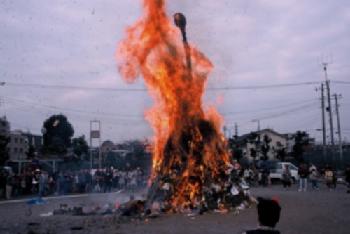
The burning hut of the God of Fire (Higashi-Naganuma)
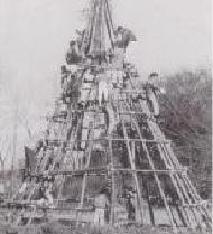
Making the frame of a hut with bamboo (Sakahama)
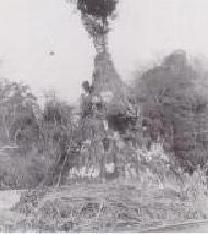
Build a hut by surrounding it with straw (100 villages)
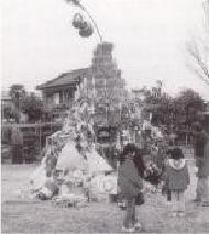
Putting decorations around (Yanoguchi)
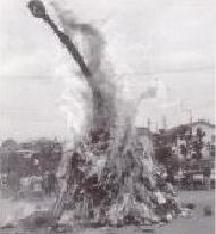
Burning a hut (Higashi Naganuma)
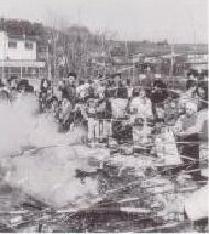
Baking Mayudama dumplings (Sakahama)
Please check here for the schedule of this year's Sai no Kami event.
Inagi City Education Department Lifelong Learning Division Tel: 042-377-2121